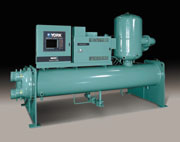Likewise on residential and light commercial equipment, EER (energy efficiency ratio) was originally used. “But EER was not representative of the entire operation of the unit,” Hubbard noted. “So something was needed to look at it from different standpoints, different parts of the year, under different loads, and so on. That’s how SEER (seasonal energy efficiency ratio) came into existence.”
Integrated part load value (IPLV) was developed similarly for chillers. “It’s a weighted formula that looks at 25%, 50%, 75%, and 100% load at off-design heads, in other words different outside temperatures, to represent the average kW/ton of the unit.”
In the United States in particular, he said, only about 1% of the time is the chiller operating at design conditions. “Most of the U.S. averages out to 1.4%.” So it’s important to consider off-design conditions to maximize efficiency.
The formula for IPLV has been revised three times to make it more accurate, remarked Hubbard. It now looks at true average weather across the country, and it provides a weighted average of kW/ton at different points.
“The biggest change that’s happened in the last 10 years or so is the way that we view efficiency, looking at the real-world operating conditions of a piece of equipment.” That’s a scenario that’s being applied to all equipment, he stated.
CARRYING THE LOAD
For any kind of unit, one thing that you don’t have a lot of control over is load. “Load is the customer. Load is what’s out there,” said Hubbard.You can do a lot of things to reduce load, such as add more insulation. This saves on energy, he declared, but it doesn’t save on efficiency. What changes efficiency in a chiller is head — how well a chiller is designed to have lower head and still operate properly.
If you keep the head the same, you won’t see a significant change in efficiency as the load varies. Although the load will range typically between 50% and 100%, “you won’t see more than about 5% variation in efficiency.”
On the other hand, if you drop the head down, “you can see a difference of 30% in the kW/ton,” Hubbard affirmed. You can go from 0.6 kW/ton to 0.4 kW/ton; if other options are applied such as variable speed, you can get to the 0.3 kW/ton range.
In a retrofit application, one of the things that can be done to improve chiller efficiency is to add a variable-speed drive. Customers who opt for variable speed on their centrifugal chillers “save on average across the U.S. about 30%,” he said.
This approach puts a brake in the system to prevent overthrow. He noted that variable speed also improves the efficiency of pumps and fans.
Variable-speed drives now provide for chillers something called adaptive capacity control. What this does, explained Hubbard, is learn the unit’s compressor so that when it gets to a point in operation where it’s not supposed to be, the control marks it and says “Don’t operate there.”
The control learns where the surge line of the compressor is and will not cross it. And as the chiller gets dirty, and the surge line moves, the control relearns where that line is.

GET IN CONTROL
Control panels also can be used to improve efficiency, maintaining closer tolerances on chilled water. “In the old days, if you go back to the pneumatic and electronic controls of pre-1985, you’d find deadbands on controlling the leaving chilled water temperature from 3¼4 to 11¼2 degrees.” So you would overshoot a lot.The newer control panels “are down to about 1¼4 of a degree, which means you don’t overshoot, and you save energy because you have less hunting, less turning on and off.”
And this is just the control for the individual unit, he stated. “In a system, having chillers work together, there are a lot of innovations that have been done in control systems to try to improve how they operate.” This again is because of the education accumulated on off-design conditions.
Today’s control panels also deliver more information, faster and easier, to assist with maintenance and repair.
Maintenance on equipment keeps it running at peak efficiency. In the case of chillers, the new controls do automatic logging, so the owner has an indication of when the tubes may be getting dirty.
Previously, logs would be done manually and often shoved in a drawer and ignored. And many chiller owners would not keep any log at all. So when service technicians come in to work on these units, they have to start from scratch.
“There’s a lot of energy efficiency lost because people don’t take these logs and evaluate them,” said Hubbard.
The new control panels take readings and produce logs automatically. There’s no need for anyone to intervene. Also, there are capabilities to examine the logs and trend them right on screen so the owner can evaluate the information more quickly.
These types of capabilities include ddc control systems, he related, which help improve the efficiency of an overall hvacr system. It can let the operator know when equipment operation isn’t quite where it ought to be.
UP ON THE ROOF
Rooftop units are likewise using control systems to improve efficiency, said Hubbard. Microprocessor controls provide similar capabilities to log data and improve the interface.Modern controls also make it easier to troubleshoot problems because of self-diagnostics.
Rooftops also now have new compressors that are tuned to the new refrigerants being used in these units.
In addition, economizers are coming into greater use than they ever have before. The efficiency issue with economizers and outside air involves fine-tuning the system while still making sure people get adequate ventilation.
Overall, he commented, the market wants to save energy as much as possible, especially because of electricity deregulation. Considering off-design conditions is key, Hubbard reemphasized, and this includes every type of equipment.
Publication date: 01/21/2002


Report Abusive Comment